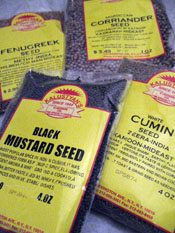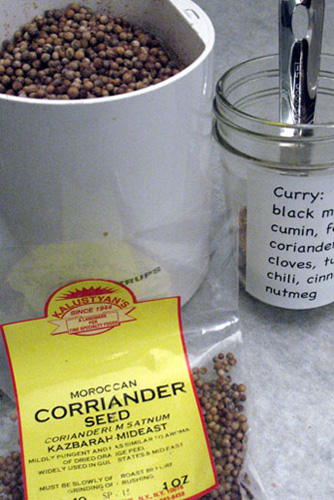A Curry Adventure
Until recently I thought curry was its own spice, the result of grinding the seeds of a curry plant that grew in India. I know. Dumb of me. Now that I have the facts I am a bit embarrassed. But my defense is that for decades, any recipe I made that called for "curry" never explained that there was more to know about those little jars of orange powder sold at the market, stacked in alphabetical order: … celery salt, cinnamon, cumin, curry….
During the December holidays I received an email from a City Cook reader who asked for some cooking advice and in a lovely gesture, thanked me by sending me her favorite recipe for Curried Butternut Squash Soup. The details on the soup itself were very light-handed but the curry, which gives the soup its really splendid flavor, was elaborate in its instructions. In something I had never seen before in a recipe, eleven different spices had to be ground together to make the elixir that would turn a plain pot of pureed squash into something so special as this soup.
She was also generous in giving credit to the curry formula itself -- it had been given to her by Chef Sumanth Das. A quick Google search told me he was born in Bombay (now Mumbai), raised in Indonesia, and has led the kitchens at Monsoon in Chicago and now at the Four Seasons Maldives.
Seeing her list of ingredients made me again turn again to Google, plus my well-used copy of Harold McGee's On Food and Cooking to educate me about curry. In restaurants I've happily eaten dishes that were called curries, but I didn't know all of what went into them. Working my way through reference books, cookbooks and the bottomless pit of information known as the Internet, I concluded that when it came to curry, there are two states of knowledge: ignorance or expertise. There is much to know but here is the tip of what I've learned.
There is indeed a curry plant but it's a type of lettuce that grows in the Mediterranean, used to flavor teas and sweets and named for what Mr. McGee calls its "vaguely spicy" aroma. Then there's curry leaf, grown in south Asia but again not what we mean when we say "curry."
I finally figured out that "curry" is a catch-all way of describing both a combination of spices as well as a way of cooking. Depending on the area of India where the spices are combined and the food is cooked, the flavors can vary dramatically, as can their intensity. Done right, the spices are ground immediately before adding to food and for some, there can be many more than the eleven spices chosen by Chef Sumanth Das.
Curry paste? That's when the spices have been ground into a powder and then combined with ghee, which is clarified butter, plus vinegar, and used in place of just the powder.
Then there's masala (not to be confused with Marsala, the fortified wine from Sicily), another Indian spice blend, one of the better known being garam masala.
I scanned some of my favorite recipe websites for dishes with the word "curry" in their title and each I found listed only "curry powder" in their ingredients. Even though curry is in fact a refined and complex flavor, most recipes treat it with no such criteria. And a quick taste of most supermarket jars of curry will reveal a mixture of spices that are dominated by coriander and turmeric.
But now I know that one curry powder may be more sweet (from cinnamon and nutmeg) or pack more heat (with chilis and peppercorns) or be deeply aromatic (with cumin and fennel seed). Perhaps this is why I didn't include curries among my favorite foods -- all too often they just tasted the same.
So what if a recipe calls for "curry powder" or if we want to cook a curry or something like Curried Butternut Squash Soup? I think the lesson here is to really know what we're adding to our food.
Which brings me back to that list of eleven spices. Most were not in my pantry, although I did have that rarely used jar of orange "curry powder" hidden in the back. Reading its label, the fine print said it included coriander, ginger, cinnamon, garlic, "and other spices," whatever they may be. Plus who knew when it was ground and packed into that little jar?
I considered the fun and flavor of making my own curry powder with Chef Das's formula:
- 12 Tablespoons coriander
- 2 Tablespoons cumin seed
- 4 teaspoons fenugreek
- 4 teaspoons black mustard seed
- 4 teaspoons fennel seed
- 2 Tablespoons black peppercorns
- 2 teaspoons ground cloves
- 1/2 cup turmeric
- 2 Tablespoons chili powder
- 2 teaspoons ground cinnamon
- 2 teaspoons grated nutmeg
With this list in hand, I went off to have a cooking adventure.
Buying and Grinding Spices
I've always had cookbooks that recommended grinding your own spices but it just seemed impractical to me. You need another gadget -- a spice grinder -- and it would add a step to whatever I'd be cooking, which meant more time. I'd tried my hand at a mortar and pestle but it was a lot of work and I never got everything to have the same texture. Of course I ground my own peppercorns with a peppermill, but other than that, my rationale was that I tended to use the same spices and thus my edited spice shelf didn't get too stale so why bother? How much better could a just-ground spice be?
But I decided that this recipe may be the exception that made the rule so I headed to Kalustyan's, the extraordinary spice shop on Lexington Avenue at East 29th Street (see our listing in "Where to Buy"). The store not only had every spice on my list -- as seed or stick or ground powder -- in small bags or large. Plus it puts together its own ground curries -- a selection that ranged from sweet to medium to hot, with all the ingredients carefully noted on each clear little bag.
I filled my basket with the individual spices, buying coriander seeds, cumin seeds, fenugreek (such a great name), and black mustard and fennel seeds. I already had a big jar of my favorite Tellicherry black peppercorns with their aggressive bite, turmeric, ground cloves, chili powder, whole nutmegs, and of course, cinnamon -- both sticks and powder.
Being in Kalustyan's is dangerously tempting for home cooks and I didn't get out of there with only my spices. I couldn't resist a small jar of preserved lemons that I'll soon use to make a Moroccan-style chicken recipe to test my new slow cooker (more in next week's newsletter), halvah for my husband, and bags of nuts and dried fruit. If you live in or visit New York, please make the trip to this special shop but if you're out of town, Kalustyan's web site is very representative of what's on their shelves.
My next stop was Bed, Bath & Beyond where I bought a Krups coffee grinder for $19.95. I had looked at electric spice grinders (Cuisinart makes one) but I could see no difference except in their higher prices and figured that if the Krups grinder I already owned could grind coffee beans into a fine powder, then it would work just as well for coriander seeds. And it did.
Important to know: don't use your coffee grinder interchangeably as a spice grinder because even if you carefully clean the little basket and blades between uses, you'll never get all the flavors and aromas out, leaving you with coffee-tasting curry and curry-tasting coffee. If you're going to grind your own spices, make the commitment and buy a second machine that you keep dedicated to that purpose. I also bought a new, clean pastry brush ($2.50 at Zabar's) so I could carefully remove all the powder in between each grinding.
Getting home I was like a kid at Christmas with newly unwrapped toys and I set to work to make my first curry. The Krups worked brilliantly and by the time I was done I had the most exquisitely perfumed kitchen as I gently mixed the individually ground spices together. Once combined, I had about two cups of Chef Das's -- now my -- curry powder. That glass jar of orange powder labeled "curry" that had sat on my shelf hit the trash.
My soup recipe only needed one and half tablespoons of this magic powder but it was all worth it -- the shopping trip, the new appliance, the grinding and mixing of the powdered spices. The soup was that good -- savory, complex, and redolent of a holiday pumpkin pie with heat. We've added a link to the recipe to the left.
Now I will find other curry recipes to bring this fragrant flavor to my table. What a wonderful cooking adventure and I suspect it has only begun. My warm thanks to Susan Z. for sending me on this journey on my own spice route.


